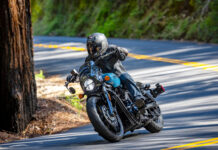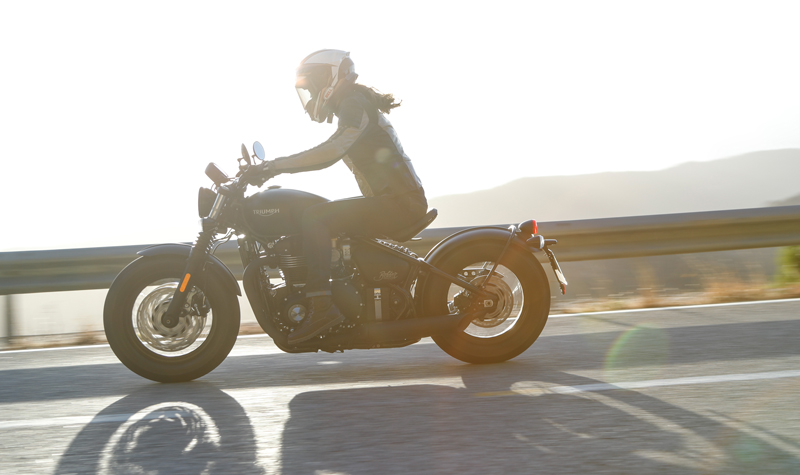
The 2017 Triumph Bonneville Bobber was one of the most highly anticipated new models to be released last year, an instant hit that quickly became the fastest selling new model in the company’s 115-year history. True to its Bonneville roots, it’s a prototypical bobber, with a solo tractor seat floating above a rear shock hidden within its hardtail-look frame, a small gas tank best suited to bombing around town, a big 19-inch front wheel (wire spoked, of course) and “bobbed” fenders.
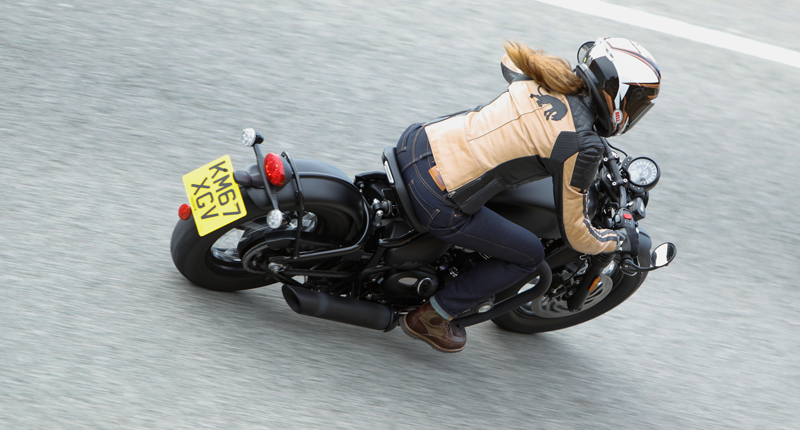
It made a great first impression on me when I first rode it back in December 2016 (read the first ride review here), despite several weaknesses (wimpy brakes, a pogo stick fork and that small gas tank). It’s so smooth and powerful—a complete package—that I was forced into calling a draw when it came down to choosing between the Triumph and the Indian Scout Bobber in a recent bobber comparo. (Read the comparison test here.) If I’d had this new Bobber Black version, however…well, who knows.
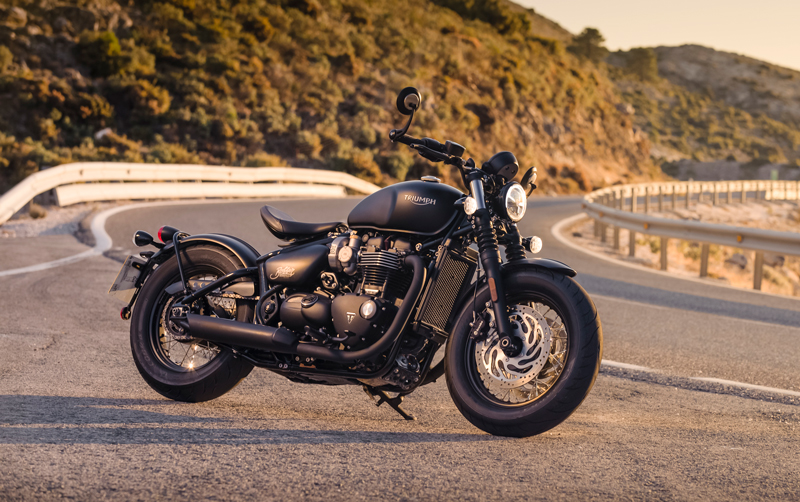
The Black is easily differentiated from its more gentlemanly twin by its smaller 16-inch front wheel (the standard Bobber’s is a 19-inch), fat front tire, dual front brake discs and black-on-black color scheme. A closer look will also reveal a chunkier 47mm (compared to 41mm) front fork, standard one-button cruise control and an LED headlight with daytime running light (DRL).
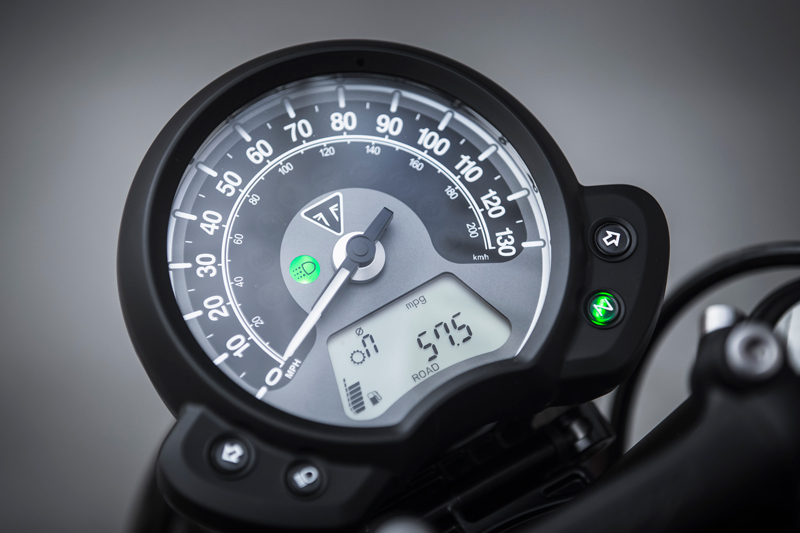
It shares everything else with its brother, including the hardtail-look frame hiding a KYB preload-adjustable shock with 3 inches of travel, a still too-small 2.4-gallon gas tank, a 59.4-inch wheelbase and a 27.2-inch seat height. There’s also the host of rider aids like two riding modes (Road and Rain, both with full power but different throttle maps), ABS, switchable traction control and an easy-pull assist clutch. These are complemented by a stylish single-dial analog speedometer and multifunction LCD display, and of course the smooth, powerful, liquid-cooled, 1,200cc high-output parallel twin that doled out 74.4 horsepower and 73.4 lb-ft of torque on the Jett Tuning dyno.
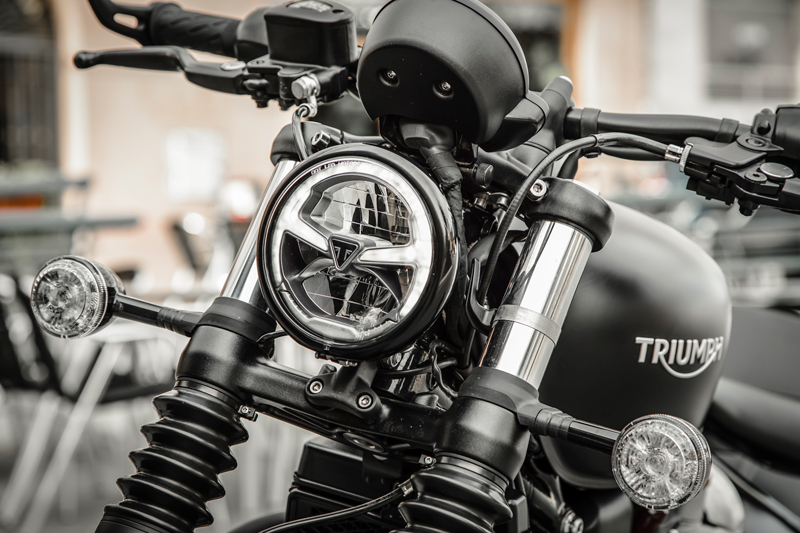
With such an excellent engine and a 6-speed transmission that snicks positively into each gear, the Bobber would benefit from some performance enhancements, and that’s where the Black comes in. Replacing the Bobber’s 41mm KYB fork is a beefy 47mm Showa cartridge-style fork, and on our short test ride the difference was noticeable. While it has the same 3.5 inches of travel, its plush, responsive character is better suited to a sporty pace, especially when things get a bit bumpy.
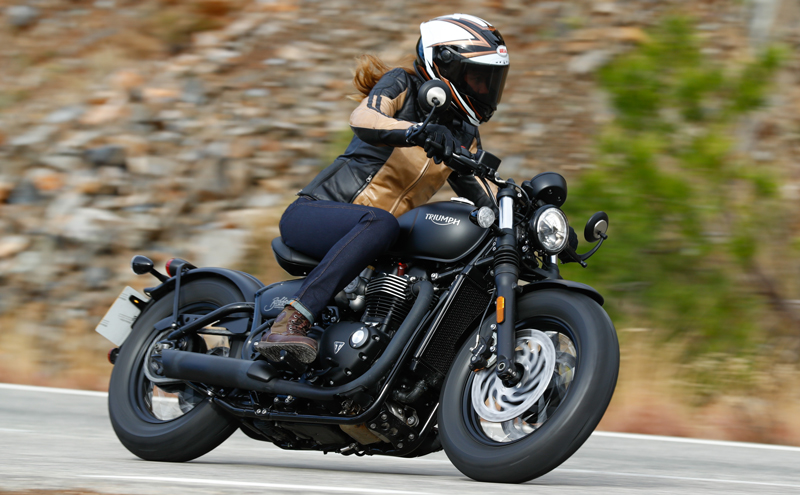
Turn in is quicker too, thanks to the 16-inch front wheel. If you read my bobber comparison test review, you saw that one of my nitpicks on the Triumph is its slowish steering. While stable in smooth corners, the original Bobber takes a bit of effort to maneuver, especially at low speeds. I wasn’t sure if the fat 130/90 front tire (the original wears a skinny 100/90) would offset any gains, but it turns out I needn’t have worried; the Black is more flickable at higher speeds and easier to handle at low speeds, while seeming to sacrifice little in the way of stability. Plus it looks cool.
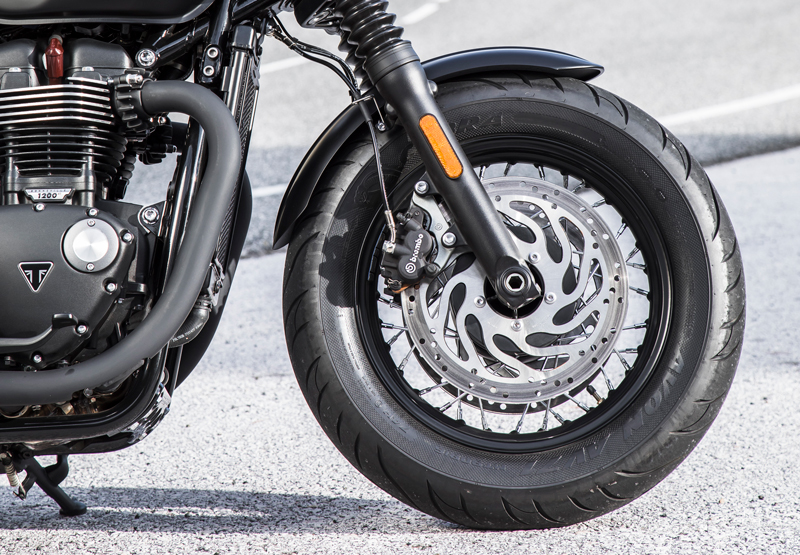
My biggest gripe on the original Bobber, however, is with its brakes. In short, they aren’t strong enough and they provide little feedback. So imagine my relief when we learned the new Bobber Black would be fitted with dual 310mm front discs instead of one, and the 2-piston calipers are up-spec Brembo units that replace the original’s Nissins. Riding hard on twisty mountain roads, braking response was markedly improved, the new dual discs hauling on the Black’s reins and making it easier to keep the chassis loaded through multiple S-curves. I would still prefer more bite and better feel, but after speaking with one of the Triumph employees who owns an original Bobber, he suggested simply upgrading to fully sintered pads.
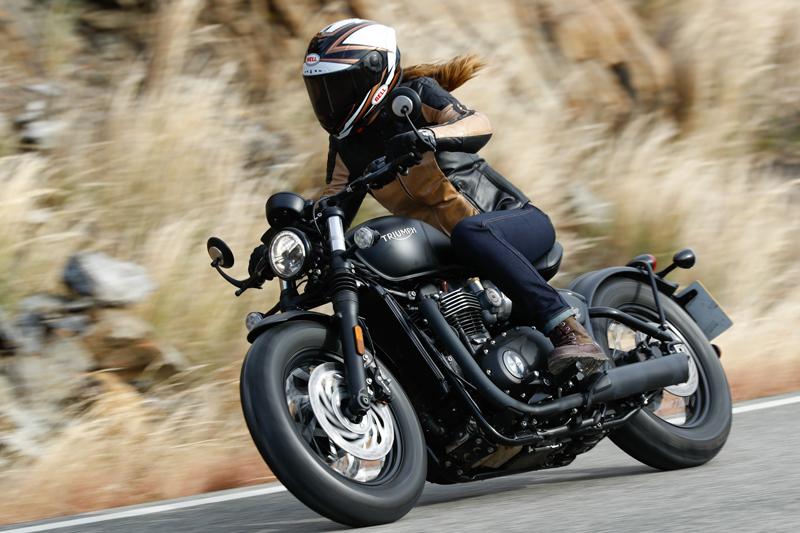
All of the Bobber Black’s other differences are mostly cosmetic, including a trick new LED headlight with DRL and the obvious blacked-out treatment (you can choose between two different versions of black: glossy Jet Black or Matte Jet Black). The exception is newly standard cruise control, which is easily operated by a single button on the left switchgear. Heated grips are still a dealer-installed option.
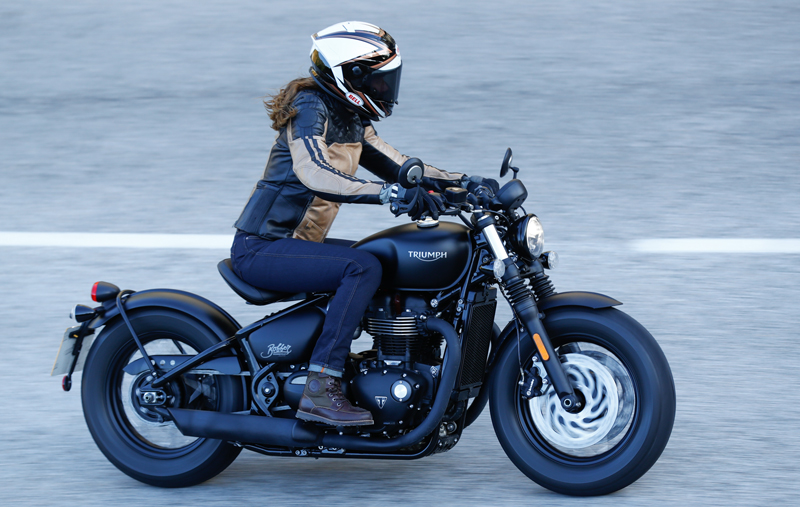
I could still complain about the small, 2.4-gallon gas tank, which limits the fun to around 114 miles (as tested). But although soft saddlebags are available as Triumph genuine accessories, if you’re in the market for a touring or road trip machine it would be best to look elsewhere. The Bobber and its Black twin were built to cruise around town—and in the right hands the Black will surprise some sport riders in the canyons.
The heavier front tire and fork, plus enhancements like the second brake disc, have resulted in what Triumph says is a 21-pound weight gain, but I can honestly say I didn’t notice it. Perhaps that would change if I were to ride the original and the Black back-to-back, but it’s a testament to the Black’s upgrades that it feels lighter on its feet than the original Bobber.
Thanks to rain and heavy winds that surprised the Costa del Sol (“Sun Coast”) on our sole riding day at the launch in Marbella, Spain, my first ride was all too short—only about 4 hours including photo and coffee stops. Or maybe Triumph has somehow figured out how to bend the weather to its will, because after my brief taste I’m only left wanting more.
Triumph says we can expect to see the Bobber Black in dealerships starting in February 2018, with a base price of $13,150 (Jet Black; Matte Jet Black carries a $250 upcharge).
Check out more new bikes in Rider’s guide to new/updated 2018 motorcycles
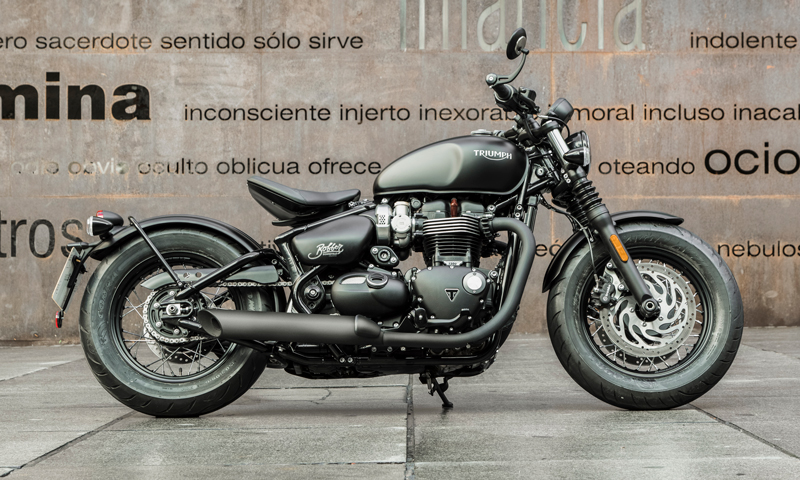
2018 Triumph Bonneville Bobber Black Specs
Base Price: $13,150 (Jet Black)
Price as Tested: $13,400 (Matte Jet Black)
Warranty: 2 yrs., unltd. miles
Website: triumphmotorcycles.com
Engine
Type: Liquid-cooled, transverse parallel twin
Displacement: 1,200cc
Bore x Stroke: 97.6 x 80.0mm
Compression Ratio: 10.0:1
Valve Train: OHV, 4 valves per cyl.
Valve Insp. Interval: 12,000 miles
Fuel Delivery: Multipoint sequential EFI w/ 44mm throttle bodies x 2
Lubrication System: Wet sump, 4.0-qt. cap.
Transmission: 6-speed, cable-actuated assist wet clutch
Final Drive: Chain
Electrical
Ignition: Electronic
Charging Output: 558 watts max.
Battery: 12V 10AH
Chassis
Frame: Tubular-steel cradle & tubular-steel swingarm
Wheelbase: 59.4 in.
Rake/Trail: 25.8 degrees/3.5 in.
Seat Height: 27.2 in.
Suspension, Front: 47mm cartridge-style Showa fork, no adj., 3.5-in. travel
Rear: Single shock, adj. for spring preload, 3.0-in. travel
Brakes, Front: Dual 310mm discs w/ 2-piston Brembo floating calipers & ABS
Rear: Single 255mm disc w/ 1-piston floating caliper & ABS
Wheels, Front: Spoked, 2.50 x 16 in.
Rear: Spoked, 3.50 x 16 in.
Tires, Front: 130/90-B16
Rear: 150/80-R16
Dry Weight (claimed): 524 lbs.
Performance
Fuel Capacity: 2.4 gals., last 0.5 gal. warning light on
MPG: 87 PON min. (avg) 47.5
Estimated Range: 114 miles
Indicated RPM at 60 MPH: 2,500
Jenny’s Gear
Helmet: Bell Star MIPS-Equipped
Jacket: Furygan Legend Lady
Pants: Bolid’ster Jeny’ster
Boots: Rev’It Royale H20

